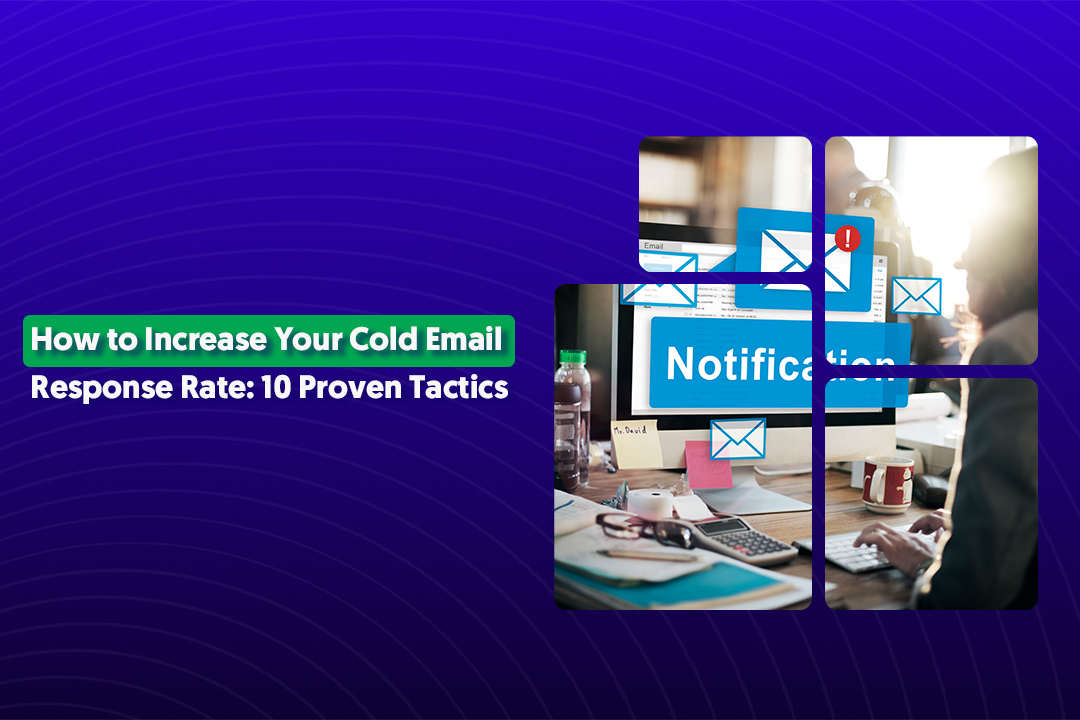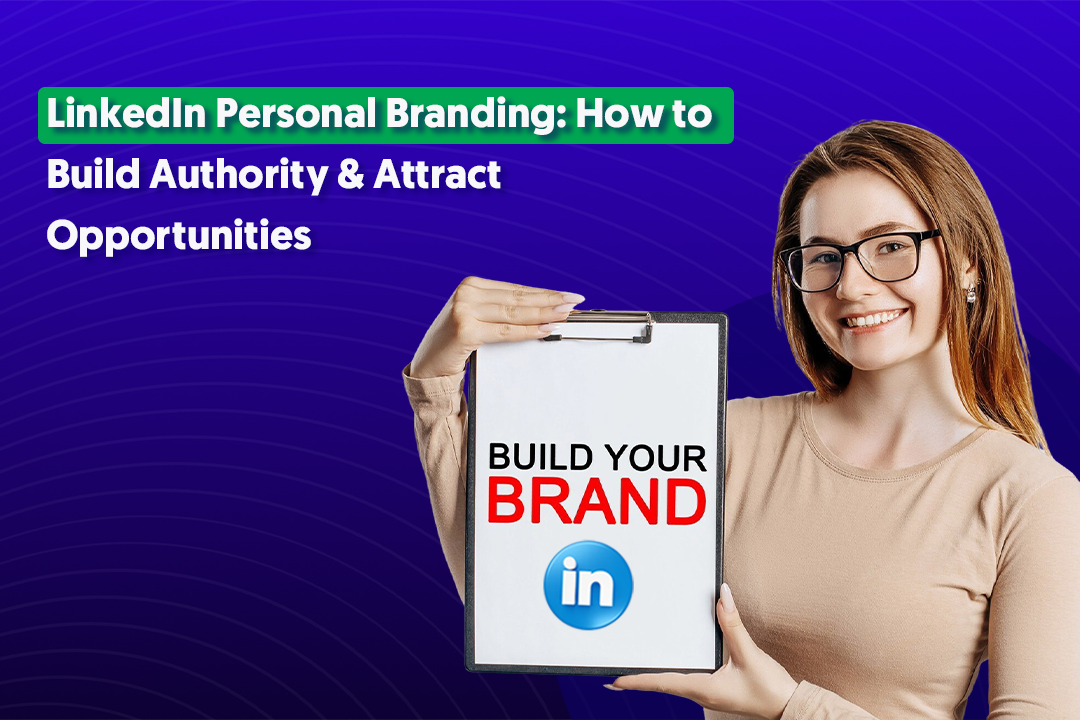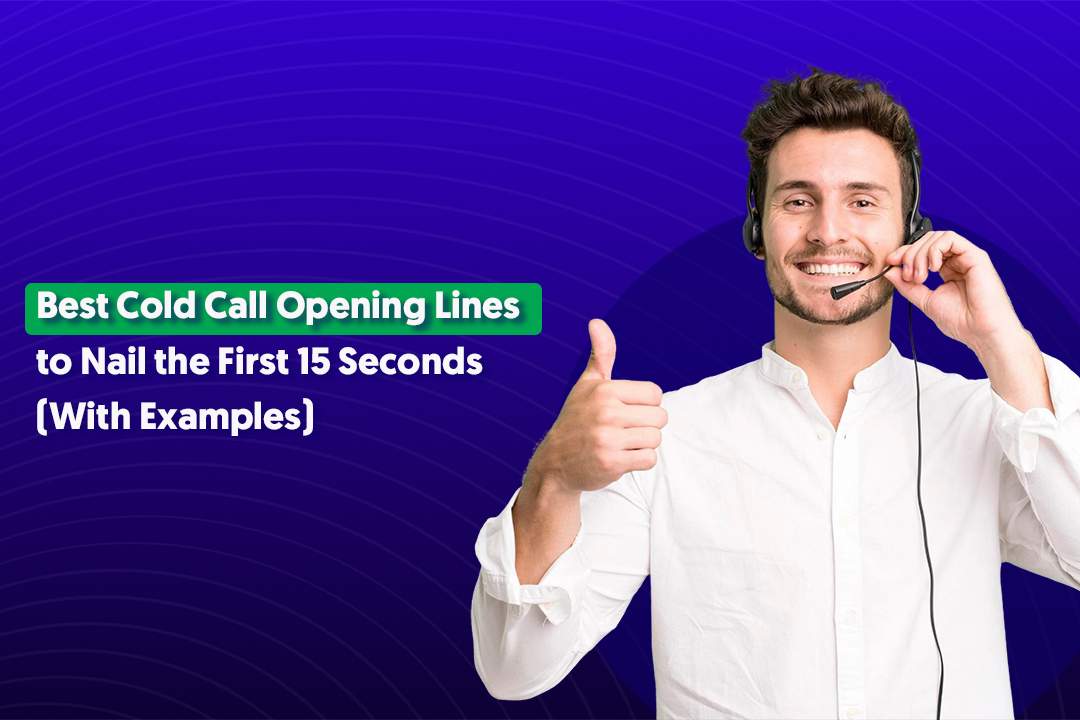Key Takeaways
- Warm up your domain first. Skipping this step guarantees spam folder placement and kills your sender reputation before you even start.
- A smaller list of perfectly-matched prospects will always outperform a massive generic database.
- Prospects decide in 3 seconds whether to keep reading, so personalization must be real and specific.
- 60% of replies come after the second follow-up, so one-and-done means leaving money on the table.
- Deliverability, open rates, reply rates, and conversions tell you what's working; adjust weekly based on data.
- Cold email works exponentially better when paired with LinkedIn engagement and content touchpoints.
When done right, cold email lead generation is still one of the highest-ROI tactics in your outbound playbook.
The numbers don't lie. Cold email delivers roughly $36 in ROI for every $1 spent , and B2B decision-makers are still opening, reading, and responding to emails that cut through the noise.
The catch? Your 2019 spray-and-pray approach won't work anymore.
Here's what's changed: inboxes are more crowded than ever, spam filters have gotten smarter, and prospects expect personalization that actually feels personal.
So what separates campaigns that book meetings from those that land in spam?
This guide breaks down the cold email outreach best practices that actually work in 2025-26.
We'll cover proven frameworks, the metrics you should be tracking, common mistakes that kill cold email response rates, and insider tactics from agencies that run thousands of campaigns (including how we do it at Cleverly).
Everything here is backed by real campaign benchmarks, expert insights, and battle-tested strategies—no fluff, just what works. Let's get into it.
What Makes Cold Email Outreach Work?
Cold email outreach isn't rocket science, but it does require getting a few critical things right. Here's what separates campaigns that work from those that don't:
The Four Key Drivers
1️⃣ Personalization at scale – Generic templates are dead. Prospects can spot a mass email from a mile away. The trick is finding ways to personalize meaningfully without spending hours on each email. Going beyond {FirstName} and actually referencing something specific about their company, role, or recent activity.
2️⃣ Deliverability and domain reputation – None of this matters if your emails never reach the inbox. Your domain reputation is everything. One bad campaign can tank your sender score and land future emails in spam, even if they're good.
3️⃣ Multi-touch sequences and channel integration – A single email rarely converts. The best cold email outreach campaigns use sequences (typically 3-7 touches) and integrate with other channels like LinkedIn, cold calling, or retargeting ads to stay on your prospect's radar without being annoying.
4️⃣ Value-first messaging – Nobody wants to be sold to in a cold email. Lead with insights, helpful resources, or genuine curiosity about their challenges. Save the hard pitch for later in the conversation.
Check This Out: Best Email Service for Cold Emails - What 10,000+ B2B Agencies Chose
What's Changed in 2025-26
The bar for cold email outreach has gotten higher. Here's why:
- AI subject line generation – Tools can now A/B test and optimize subject lines in real-time, but they've also made prospects wary of "too-perfect" copy that feels robotic.
- Inbox reputation is everything – Email providers like Google and Microsoft now track engagement signals (opens, replies, deletions) to determine if you're a trusted sender.
- Privacy regulations matter – GDPR, CAN-SPAM, and CCPA aren't suggestions. Non-compliance can result in hefty fines and domain blacklisting.
- Cross-channel lead generation is expected – Cold email outreach works best when paired with LinkedIn outreach, content marketing, and retargeting.
Spam filters are smarter, automation is better, and prospects expect more. The campaigns that win are the ones that adapt.
8 Cold Email Outreach Best Practices That Drive Results
Follow these eight best practices for cold email outreach and you'll dramatically improve connection, reply, and conversion rates.
1. Warm Up Your Domain and Inbox First
Before you send a single cold email, you need to build trust with email providers. Here's how:
Use a separate sending domain – Never send cold outreach from your primary business domain. If something goes wrong, you don't want to tank the reputation of the domain your team uses daily. Set up a subdomain (like outreach.yourcompany.com) and properly authenticate it with SPF, DKIM, and DMARC records.
Start small and build engagement – Don't go from zero to 500 emails a day. Start with 10-20 emails per day for the first week, then gradually increase volume. Send some manual emails to colleagues or warm contacts to build positive engagement signals before launching your campaign.
Use email warmup tools – Services like Mailreach, Warmy, or Instantly Warmup automate the process by exchanging emails with other inboxes to establish your sender reputation.
Skip this step and you're gambling with deliverability from day one.

2. Define & Target Your Ideal Customer Profile (ICP)
Spray-and-pray doesn't work anymore. The tighter your targeting, the better your results.
Build a detailed ICP that includes:
- Job titles and roles (VP of Sales, Head of Marketing, etc.)
- Industry and company size
- Tech stack they're likely using
- Specific pain points your solution addresses
- Budget authority and buying timeline
Verify and enrich your list – Use tools like ZeroBounce or NeverBounce to clean your data before sending. Invalid emails hurt deliverability and waste your sending capacity.
Quality over quantity wins every time when it comes to best practices for cold email outreach.

3. Use Emotion + Context + Value in Your First Line
When writing a cold email, always remember that your first line is make-or-break. Prospects decide whether to keep reading in the first three seconds.
Make it personal and specific – Reference a recent company milestone, a post they shared on LinkedIn, or something relevant to their role. Generic intros like "I noticed your company is growing" get deleted instantly.
Keep it short – Aim for under 100 words total. Three sentences max. Think: personalized hook, quick value statement, simple CTA.
Avoid these killers:
- Marketing jargon and buzzwords
- Hype language ("game-changing," "revolutionary")
- Generic value props like "We help companies increase revenue"
👍 Good example: "Saw your post about struggling with SDR turnover—we've helped three SaaS companies in your space cut ramp time by 40%. Worth a quick chat?"
👎 Bad example: "We're a leading provider of innovative solutions that help companies like yours transform their sales process and achieve unprecedented growth."
See the difference? One feels human. The other screams template.
Learn How-to: Write a Friendly Reminder Email That Gets Replies (100% Working Templates)
4. Stick to a Short 3–5 Step Follow-Up Sequence
Here's the thing: 60% of replies come after the second to fourth follow-up. If you're only sending one email, you're leaving money on the table.
Sample sequence that works:
- Day 0: Initial outreach with personalized hook and value
- Day 3: Brief follow-up referencing first email, add one new piece of value
- Day 7: Share a relevant case study or insight (no ask, just value)
- Day 10: Final check-in with a different CTA or breakup email
Follow-up best practices:
- Keep each follow-up shorter than the last
- Change your CTA each time (don't just say "any thoughts?" four times)
- Add micro-value in every touch—a tip, stat, or resource
- Don't be afraid of the breakup email ("Should I close your file?")—it often gets responses
The key to best practices for cold email outreach is persistence without being annoying. There's a fine line, and spacing matters.
5. Integrate Multi-Channel Touchpoints (Email + LinkedIn + Content)
Cold email outreach works exponentially better when it's not happening in isolation.
Why multi-channel matters: Prospects need multiple touchpoints before they trust you enough to respond. Seeing your name in their inbox AND on LinkedIn AND in their content feed builds familiarity faster.
Example workflow that converts:
- Engage with their LinkedIn content (thoughtful comment)
- Send connection request with brief note
- Wait 2-3 days, send first cold email referencing the LinkedIn interaction
- Follow up via email while staying active on their posts
- Retarget with ads if they visit your site
This approach lifts reply rates by roughly 40% compared to email-only campaigns. You're not just another cold email—you're someone who's genuinely engaged with their world.

6. Monitor Metrics & Optimize Continuously
You can't improve what you don't measure. Track these metrics religiously:
Core metrics to watch:
- Deliverability – Are your emails reaching inboxes? (Target: >95%)
- Open rate – Are subject lines working? (Target: >60%)
- Reply rate – Is your message resonating? (Target: >15%)
- Meeting conversion – Are replies turning into calls? (Target: >4%)
- Pipeline generated – What's the actual revenue impact?
Optimize relentlessly – A/B test subject lines, send times, first lines, and CTAs. Small changes can have big impacts. We've seen open rates jump 20%+ just by changing send time from morning to early afternoon.
Use the right tools – Platforms like Instantly, HubSpot, or Smartlead give you dashboard visibility into what's working and what's not. Review weekly and iterate.
The best cold email outreach campaigns are never "set it and forget it"—they're constantly evolving based on data.
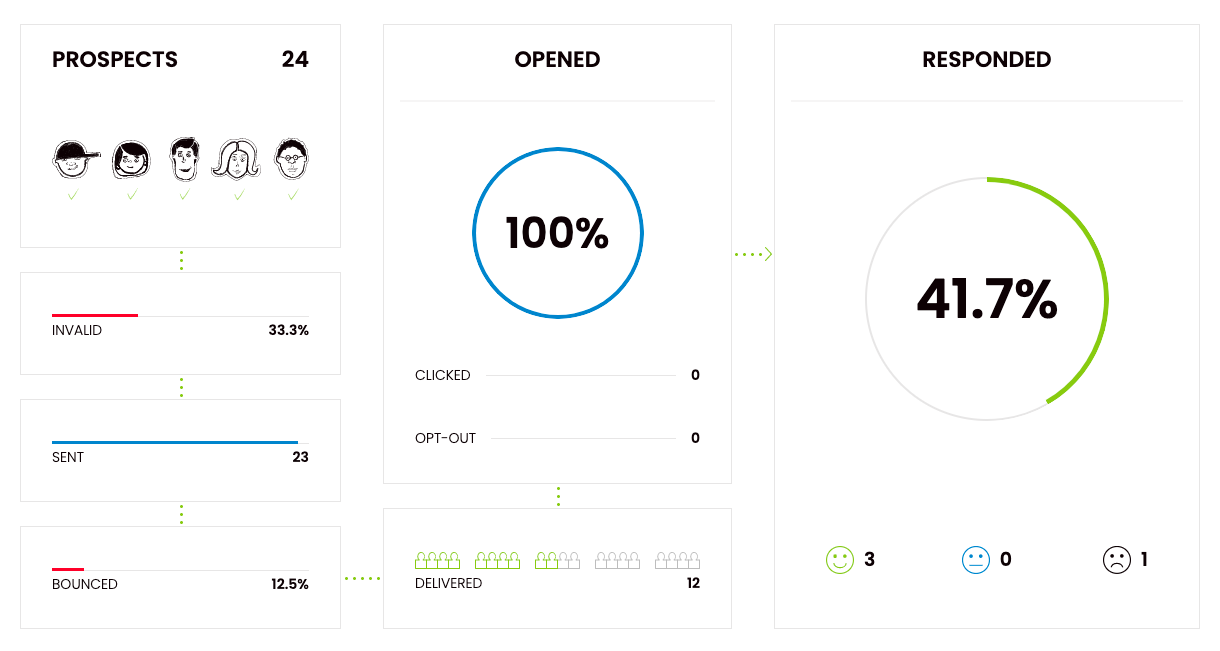
7. Respect Compliance & Maintain List Hygiene
This isn't sexy, but it's critical. Mess up compliance and you risk fines, blacklisting, and destroying your domain reputation.
Non-negotiable compliance basics:
- Include an opt-out link in every email (CAN-SPAM requirement)
- Honor unsubscribe requests immediately—within 24 hours
- Clearly identify who you are and why you're reaching out
- If you're emailing EU contacts, ensure GDPR compliance
- For California contacts, respect CCPA guidelines
List hygiene matters too:
- Remove hard bounces immediately
- Scrub your list of spam traps and invalid emails
- Avoid spam trigger words (free, guarantee, act now, limited time)
- Monitor engagement and suppress non-responders after your sequence ends
Your domain reputation is a long-term asset. Protect it like you would your brand. One careless campaign can take months to recover from.
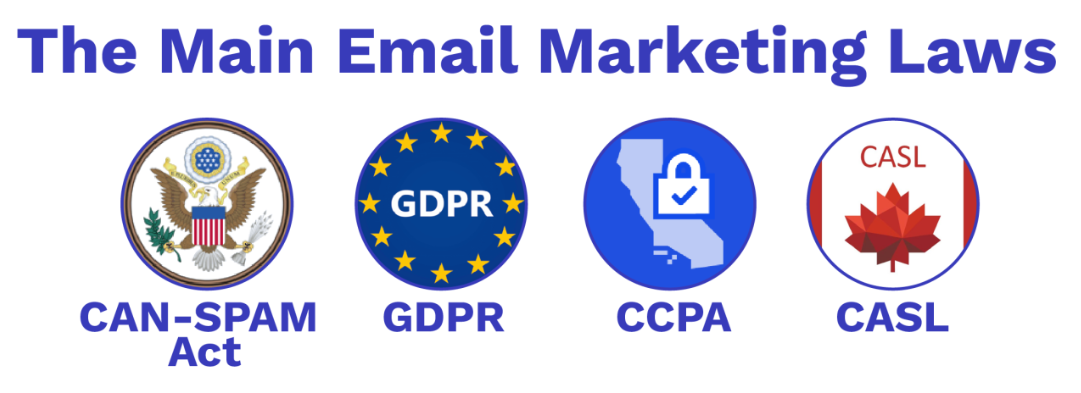
8. Create a System for Scaling Without Losing Quality
Once you've found a formula that works, it's time to scale—but not at the expense of quality.
How to scale the right way:
Automate the workflow, not the personalization – Use automation tools for sequencing and follow-ups, but keep human review on first lines and key touchpoints. AI can help with personalization at scale, but your tone needs to stay human.
Integrate with your CRM – Set up proper lead routing and SDR hand-off processes. When someone replies, they should get a response within an hour, not fall into a black hole.
Document your playbook – Create templates, but leave room for customization. Your SDRs should know exactly what to say at each stage, but still sound like themselves.
Example scalable process:
- Build list with ICP filters
- Enrich and verify data
- Segment by persona or pain point
- Apply message templates with personalization tokens
- Load into sending tool with sequence
- Auto-sync replies to CRM
- Route qualified leads to sales
- Track meetings and pipeline
The goal is repeatable results. Find what works, systematize it, then scale with confidence while maintaining the quality that got you results in the first place.
That's the ultimate best practices for cold email outreach approach.
Real-World Cold Email Outreach Blueprint Examples
Theory is great, but let's look at how these cold email outreach best practices play out in the real world.
Here are three campaigns we ran that show what's possible when you get the fundamentals right.
Case Study 1: Alo Media Group (Financial Services)
Results: 33 meetings booked in 6 months | 31% reply rate
Alo Media Group specializes in SaaS customer acquisition, so we needed a strategy that demonstrated their expertise from the first touchpoint. Here's what worked:
The timing angle – We targeted companies immediately after securing funding rounds. These prospects were actively investing in growth and customer acquisition, making the timing perfect for Alo's services.
Infrastructure that delivers – We used an enterprise Azure setup with dual authenticated domains and 100 Outlook accounts to ensure emails reached B2B inboxes consistently. Deliverability isn't sexy, but it's the foundation.
Precision targeting – Six-source verification helped us identify and reach the actual decision-makers, not just generic contact emails. We focused on companies where Alo had proven CAC reduction metrics from similar clients.
The message – Instead of generic pitches, we referenced specific challenges these funded companies face and showcased relevant case studies showing how Alo reduced customer acquisition costs for comparable SaaS businesses.
The result? 35+ qualified leads in the first 90 days, converting to 33 meetings over six months with a 31% reply rate—well above industry benchmarks.
"Cleverly takes a lot of stress off my mind. I know I'm going with one of the best lead gen providers in the space." – Alo Media Group
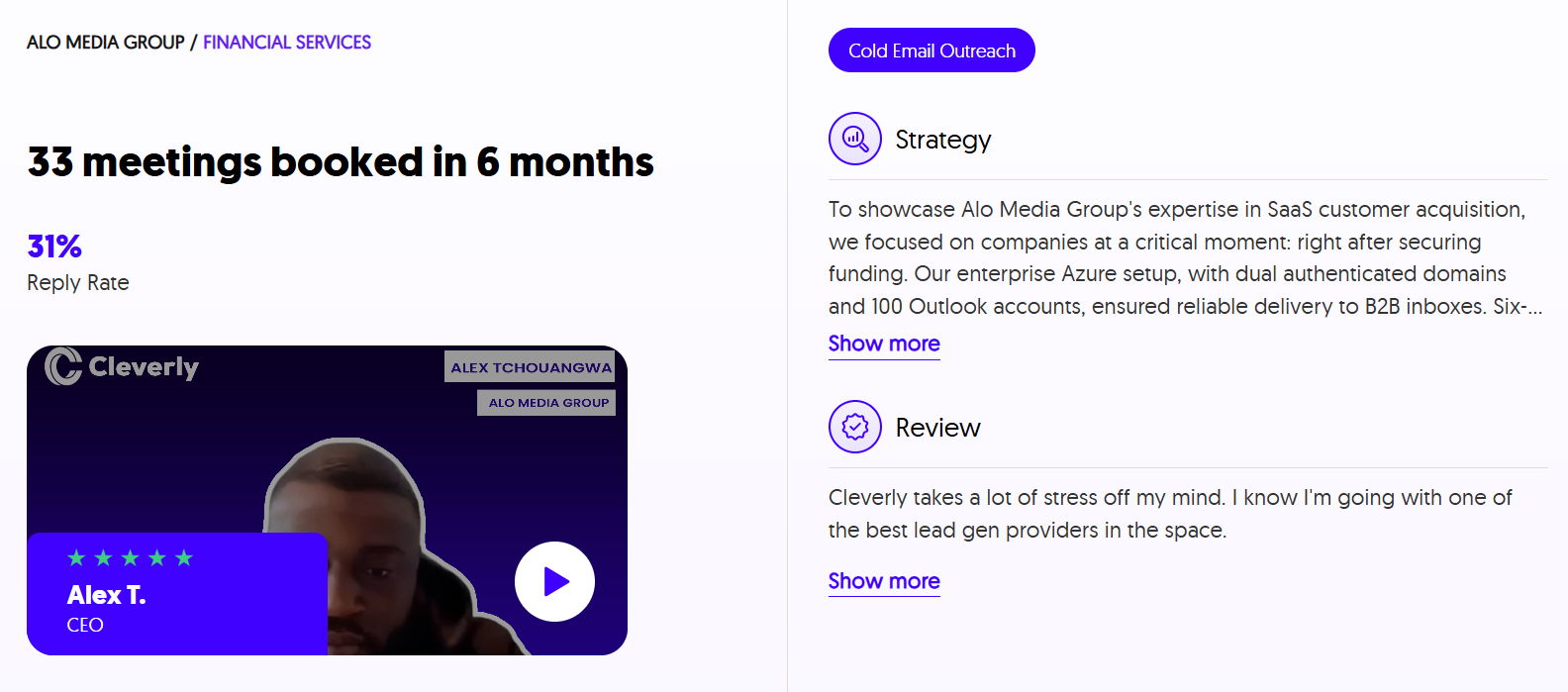
Case Study 2: Ammo Studio (Design)
Results: 10 new clients in 5 months | 78 average replies per month
Ammo Studio does web design for AI startups—companies building complex technology that's hard to explain visually. We positioned them as the solution to a very specific pain point.
Hyper-targeted ICP – We went after funded AI startups (identifiable by ".AI" domains and recent funding announcements) whose technical leaders were struggling to improve demo conversion rates. Multi-provider verification ensured we reached the right people.
Enterprise infrastructure – Using 2 USA IPs and 100 Outlook inboxes on Azure gave us the deliverability muscle to reach technical decision-makers who are notoriously hard to get in front of.
Problem-first messaging – Our emails didn't lead with "we do great design." They opened with the challenge: "Most AI startups lose prospects during demos because the tech is too hard to visualize." Then we showed how Ammo solves that exact problem.
This focused approach resonated immediately, generating 78 monthly replies and converting 10 AI companies into paying clients within 5 months. This is cold email outreach best practices in action—tight targeting, clear value, consistent follow-through.
"The leads are all pretty high quality—and we got a close out of it!" – Ammo Studio
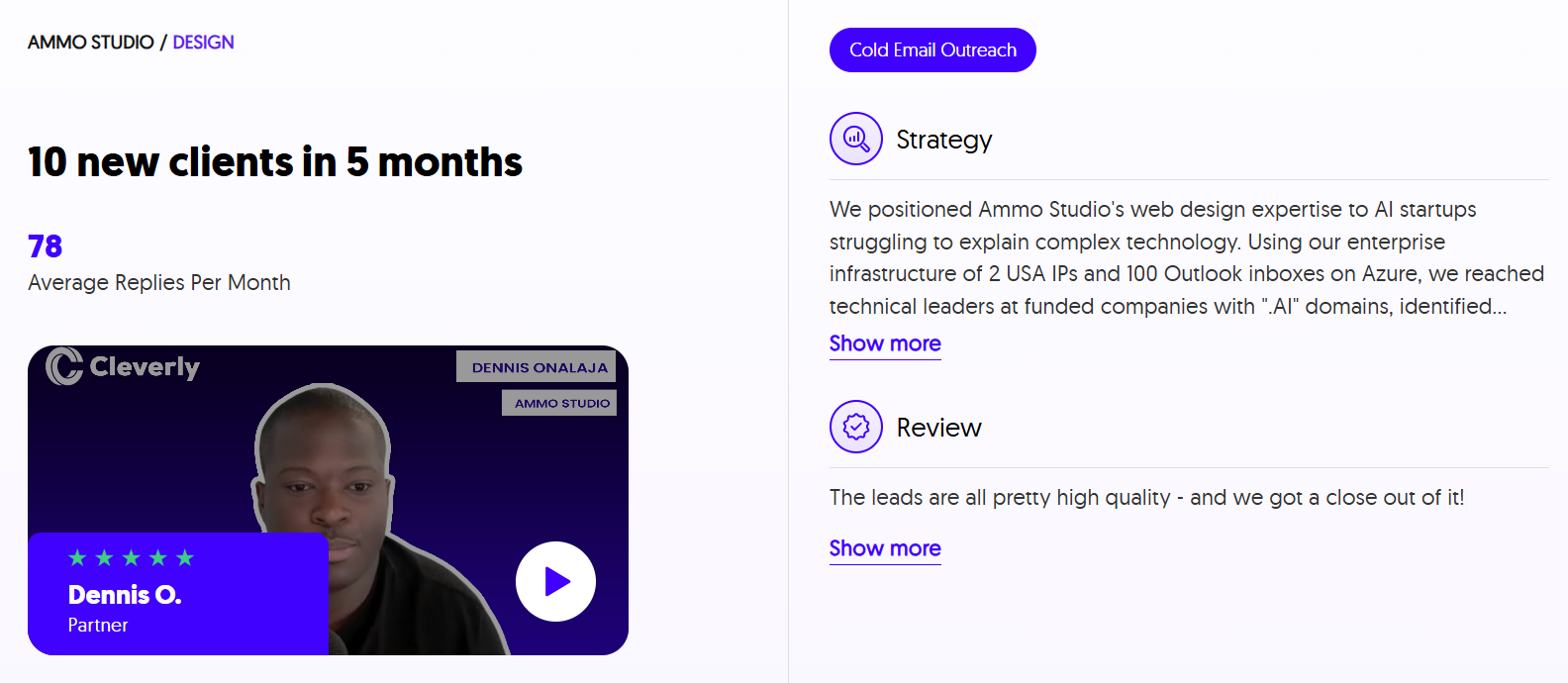
Case Study 3: App Labs (Software Development)
Results: $15,000 in closed deals in 2 months | 42% reply rate
App Labs builds AI applications for scaling tech companies. The key was finding prospects at the exact moment they needed this expertise.
Smart segmentation – We targeted funded tech startups actively expanding their AI capabilities (identified through job postings, funding announcements, and tech stack signals). Six-source verification ensured we reached technical decision-makers, not gatekeepers.
Proven infrastructure – Our enterprise Azure setup with 2 USA IPs and 100 Outlook accounts delivered consistent inbox placement to notoriously skeptical technical audiences.
Results-focused messaging – Instead of explaining what App Labs does, we highlighted specific deployment successes with similar companies. We showed prospects exactly what outcomes they could expect and backed it up with real examples.
The 42% reply rate speaks for itself. Within two months, App Labs closed $15,000 in new business—immediate positive ROI from the campaign.
"We have closed 2 deals with the leads Cleverly gave us, which gave us an immediate positive return on investment." – App Labs

What These Campaigns Have in Common:
All three followed the same cold email outreach best practices: enterprise-grade infrastructure for deliverability, hyper-targeted prospect lists verified through multiple sources, messaging that addressed specific pain points rather than generic value props, and consistent multi-touch sequences that stayed human.
The results weren't luck—they were the outcome of getting the fundamentals right and optimizing relentlessly based on data.
How Cleverly Supports Cold Email Outreach for B2B Teams
You've seen the best practices—now here's how to implement them at scale without building the entire infrastructure yourself.

At Cleverly, we've helped over 10,000 clients generate leads with companies like Amazon, Google, Uber, PayPal, Slack, and Spotify.
The results? $312 million in pipeline revenue and $51.2 million in closed revenue.
Here's what makes us different as a cold email outreach agency: you only pay for meeting-ready leads.
Not opens. Not replies. Not "interested" responses that go nowhere. You pay when we deliver a qualified prospect who's ready to take a call.
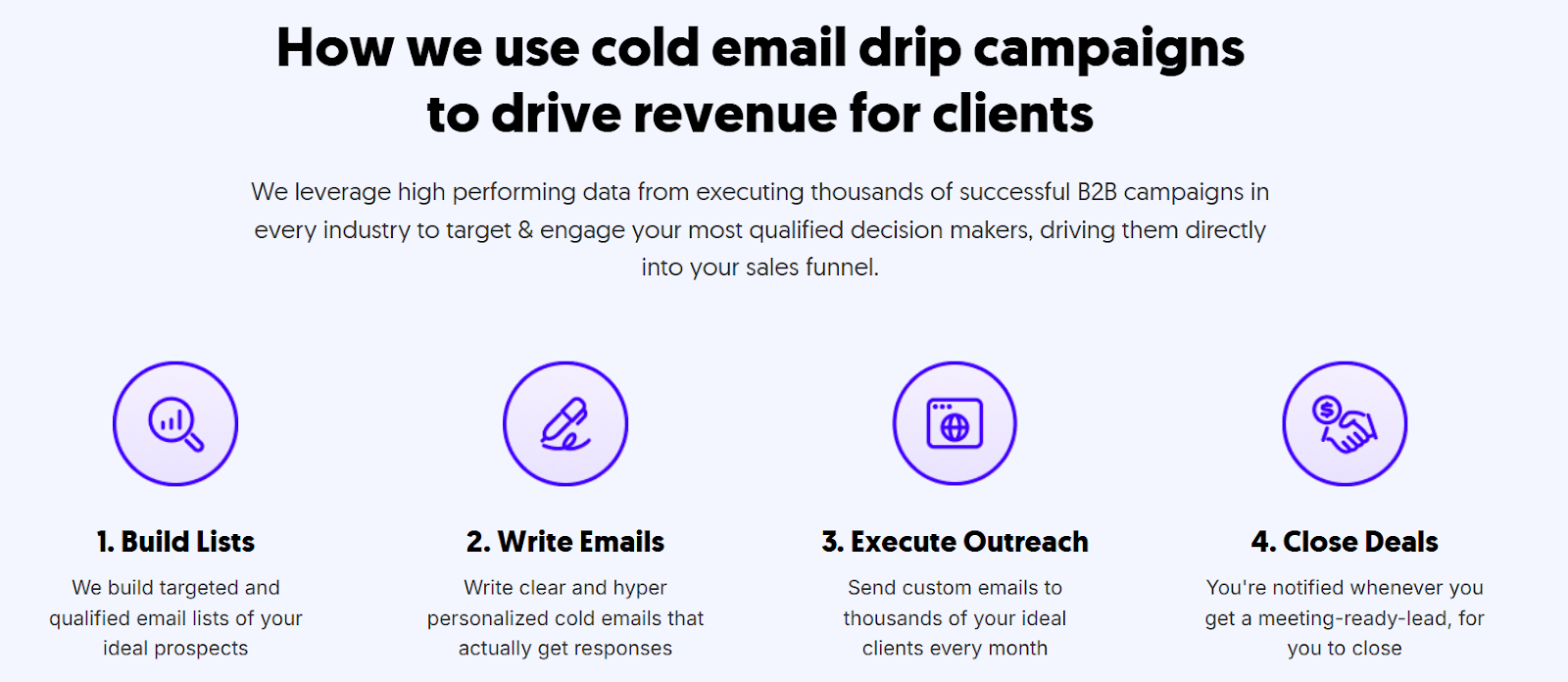
We handle everything—domain setup, list building, message crafting, sequence management, deliverability optimization, and follow-ups.
You get qualified meetings dropped directly into your calendar.
If you're tired of mediocre results from DIY campaigns or agencies that charge monthly retainers regardless of performance, let's talk.
We've already proven this works for 10,000+ companies. Yours could be next.
Book a strategy call and let's build your pipeline!

Conclusion
Cold email outreach best practices haven't changed as much as you'd think—but the execution standards have gotten way higher.
The fundamentals still work: warm up your domains, target the right people, personalize at scale, follow up strategically, and optimize based on data.
What's different in 2025-26 is that prospects can spot lazy outreach instantly, and email providers will punish you for it.
The good news? When you get it right, cold email remains one of the highest-ROI channels available.
The campaigns we showed you aren't outliers—they're what happens when you combine tight targeting, strong deliverability infrastructure, value-first messaging, and consistent follow-through.
Start with one or two of these best practices for cold email outreach, test what works for your audience, then scale from there.
Or partner with a cold email outreach agency (like us) that's already figured it out and let them handle the heavy lifting while you focus on closing deals.
Frequently Asked Questions



